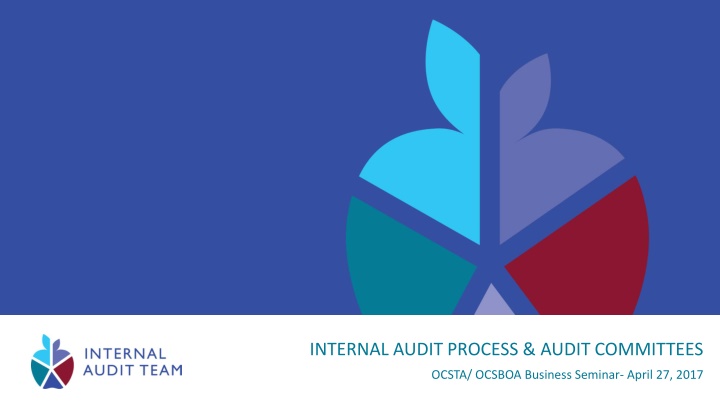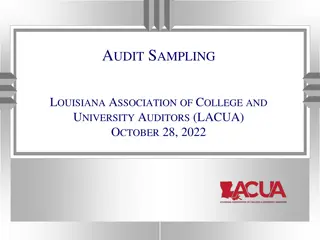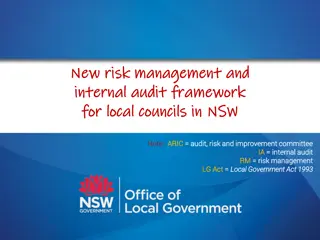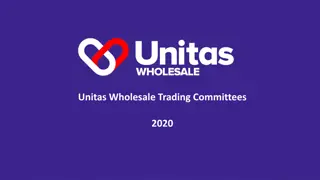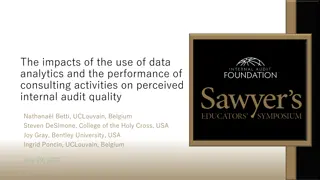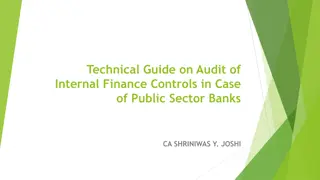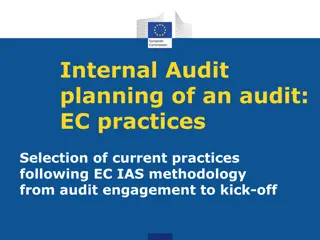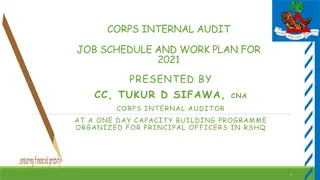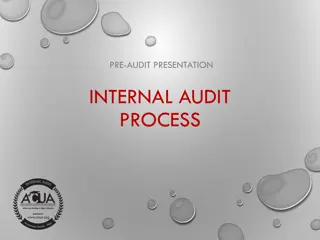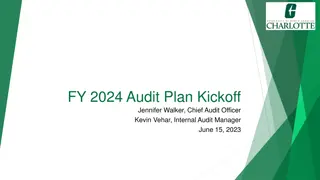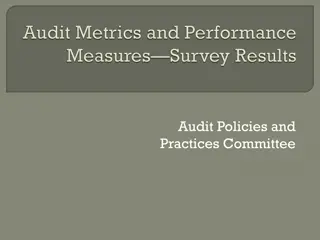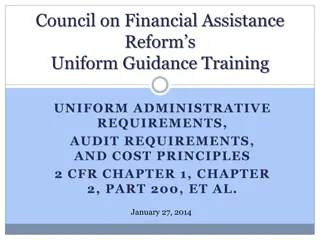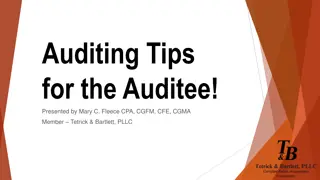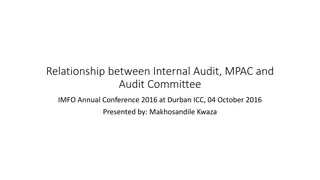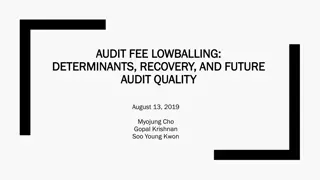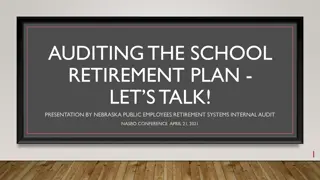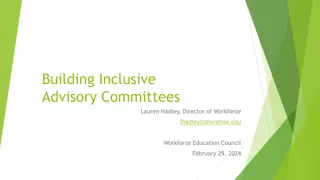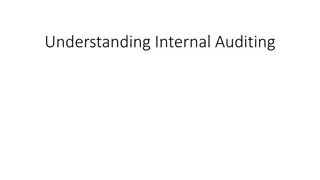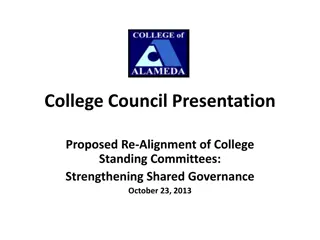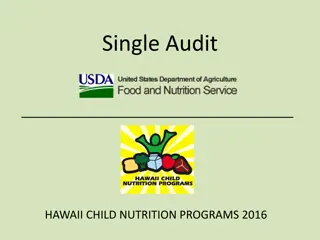Internal Audit Process & Audit Committees Overview
Explore the functions and responsibilities of internal audit processes and audit committees in the context of school boards in Ontario. Covering topics such as governance, risk management, compliance, and internal controls, the content delves into the structure, mandate, and activities of internal audit teams, emphasizing their role as independent and objective advisors driving value for educational institutions. Recent developments and accomplishments highlight the evolving landscape of internal audit practices in the education sector.
Download Presentation

Please find below an Image/Link to download the presentation.
The content on the website is provided AS IS for your information and personal use only. It may not be sold, licensed, or shared on other websites without obtaining consent from the author.If you encounter any issues during the download, it is possible that the publisher has removed the file from their server.
You are allowed to download the files provided on this website for personal or commercial use, subject to the condition that they are used lawfully. All files are the property of their respective owners.
The content on the website is provided AS IS for your information and personal use only. It may not be sold, licensed, or shared on other websites without obtaining consent from the author.
E N D
Presentation Transcript
INTERNAL AUDIT PROCESS & AUDIT COMMITTEES OCSTA/ OCSBOA Business Seminar- April 27, 2017
Agenda IA Overview Financial Reporting Risk Assessment Flow of Information strategic advisors and catalysts for change
Who we are Internal audit mandate Ontario Reg. 361/10 8 regions for 72 school boards Independent and objective Working for school boards Diverse skill set Professional standards Adding value
What we do Governance, Risk Management, Compliance, Internal Controls Audit universe Type of engagements Audits Consulting Continuous monitoring UNIVERSE Human resources IT & Communications Business services Other Transportation Instruction & Schools Facilities RISK PRIORITIZE (process, activities, structures, initiatives, context, etc.) AUDIT PLAN DEVELOPMENT ASSESSMENT Projects based on needs and capacities Impact x Probability Dual reporting relationship
Structure Other central oversight / regulating bodies Audit Committee The Board (Governing Body) Ministry of Education DG, Supervisory Leaders External Audit 3rd Line of Defense 2nd Line of Defense Financial Control Security Risk Management Quality Inspection Compliance 1st Line of Defense Internal Audit Management Controls Internal Control Measures
Past Developments Changes to Ontario Regulation 361/10: Audit Committees (July 2015) Allows any audit committee member to be Chair (previously only trustee members); The audit committee is now required to make recommendations to the Board on the content of the external audit plan and on all proposed major changes to the plan; and Amendments to Ministry reporting requirements. Guidance on what to include in open and closed audit committee sessions (Deloitte, Nov 2015) Internal Audit and The Role of Audit Committees (Module 19, 2016: SB05) Province-wide trustee training (held early 2015) Regional Internal Audit Coordinator
Recent Accomplishments Internal Audit Professional Development Conferences Auditor training on the education sector Development & implementation of a leading practice repository (Dec. 2016) Standardization across Regional Internal Audit Teams (where possible) Regional internal audit branding Increasing consistency - Number of audits per year - Audit follow-up activities - Performance reviews - Update and use of standardized internal audit templates and tools (mandate, internal audit report, manual)
Join Us For further information: Trustee Professional Development Program - http://www.ontarioschooltrustees.org Ontario Regulation 361/10 - http://www.ontario.ca/laws/regulation Good Governance: A Guide for Trustees, School Boards, Directors of Education and Communities - http://cge.ontarioschooltrustees.org/fr/download.html The Institute of Internal Auditors - https://na.theiia.org/Pages/IIAHome.aspx
FINANCIAL REPORTING OCSTA/ OCSBOA Business Seminar- April 27, 2017
Financial Reports Key topic identified by participants of previous audit committee training sessions/presentations As an audit committee member I am expected to review and make recommendations to the Board on the financial statements, how can I be better informed to make a recommendation? Desire to know more about what to look for- where, when & how What types of financial reports will assist in informing your understanding of the fiscal health of the Board? What are some of the key indicators to look for and inquire of management? What types of reports can management provide?
Financial Reporting and Review Audit committees must: Discuss significant financial risks and measures to monitor and manage these risks Review materials from the external auditor including the audited financial statements Review and recommend approval of the financial statements to the Board May also review financial information from other sources, in line with leading practices
Reporting Management has various reporting tools that provide key financial information Reports developed by management communicate their monitoring of budget to actual tracking with prior year(s) comparisons Tracking of budget to actual includes: staffing levels, enrolment, revenues (from all sources) and expenditures Important to note that there is no one right reporting tool Management will develop and use the tools that work best for their needs and system capabilities For illustrative purposes and to support Boards in developing interim financial reporting tools the Ministry developed a sample template (2015:SB10 Interim Financial Reporting)
Sample Reporting Template Interim Financial Reporting Template 2015 SB10 Interim Financial Reporting.xls
Table Activity In your opinion, what are the key elements that would potentially impact your Board s financial position? What can you plan for and what is unexpected? What are you concerned about in relation to your Board s financial position?
RISK ASSESSMENT OCSTA/ OCSBOA Business Seminar- April 27, 2017
What is Risk? Risk is the possibility of an event occurring that will impact the achievement of your school board s objectives
Examples of Risk A school board faces risk from a variety of sources: A young student is dropped off at the wrong bus stop EQAO math scores drop sharply year over year A hacker gains access to confidential employee and/or student data Cash is stolen from a fundraising event A school is heavily damaged in a tornado, causing the school to be closed for a long period
Risk Assessment Limited resources to manage risks - Prioritize through risk assessment Risks are typically assessed in terms of likelihood and impact - Likelihood: The probability that the event will occur board reputational, operational, etc.) - Impact: The extent to which the event might affect the school Typically considers multiple criteria (financial,
Sample Risk Rating Scales Likelihood Description High Almost certain to occur at least once in the next year Medium May occur in the next 2-9 years Low Not likely to occur in the next 10 years Impact Description High One or more strategic objectives not achieved Medium Moderate impact on achievement of objectives Low Minor or no impact on the achievement of objectives
Risk Matrix Risk A school is heavily damaged by a tornado, causing a long-term closure High (3) Medium (2) IMPACT Likelihood = Low (1) Low (1) Impact Overall Risk Score = = High (3) Medium (3 x 1) Low (1) Medium (2) High (3) LIKELIHOOD
Developing the Internal Audit Plan Minimum two audits per school board limited capacity Focus internal audit resources on highest risks and greatest capacity to provide value, as identified: - Through discussions with management on areas of concern - Through the risk assessment Keep the audit plan current (1- 3 years) - Velocity of change in risk - Flexibility Internal audit presents the plan to the audit committee, which then recommends the content of the plan to the Board
Top Audits 2012-13 Procurement & Accounts Payable/ Purchasing Cards/ Expense Reporting Budget Planning, Development & Control School Generated Funds Enrolment 2015-16 Payroll, Compensation & Benefits Manage IT Security, Network & Application Access Management Special Education Attendance Support
Table Discussion 1. Individually, take five minutes and determine what you feel are the top three risks for your school board 2. Discuss these with your table group 3. For three of the risks identified at your table, work together and plot these risks on a 3x3 risk matrix 4. For one of the risks discussed at your table, be prepared to present the risk and explain where you plotted it on the matrix
FLOW OF INFORMATION OCSTA/ OCSBOA Business Seminar- April 27, 2017
Guideline on Audit Committee Reporting Annual Reports: Detailed report to the Board High level report to the Ministry By-laws may require a meeting report to the Board after every audit committee meeting Both annual reports are typically brought forward at the September or November audit committee meeting
Approval by the Board The audit committee will recommend for Board approval: Internal audit plan External audit plan Audited financial statements
Open vs. Closed Meetings Evolving area across the sector Each audit committee should develop criteria for topics to be included in their open or closed committee sessions Follow principles of transparency and accountability Consider each agenda item Guidance report from Deloitte
Open vs. Closed vs. In-Camera Open meetings Open to the public, announced on Board website Transparency Closed meetings Limited to audit committee members, Board of Trustees, management, auditors, legal counsel In-camera sessions No decision making
Open vs. Closed Meeting Agenda Items Agenda Item Open Closed Internal audit reports X Auditing team s performance review X Internal audit follow-up reports X Audited financial statements X Internal audit mandate X Audit engagement letter X Discussion of the Board s significant risks X Interim financial reports X Annual internal/external audit plans X X Annual report to the Board of Trustees X X
Table Activity 1. A review of 20 expense reports from a principal at a local school identified a number of trivial purchases made by the principal. The review identified a claim where two televisions were purchased. When the auditor asked to physically see the televisions to ensure they were being used for educational purposes, the principal was able to show the auditor one. When questioned where the other television was the principal broke down and admitted he took it home for personal use. Looking at the expense claim, the auditor noticed the principal s claim was not reviewed and signed off by the superintendent as required by Board policy. Should this matter relating to fraud be disclosed in an open or closed session of the audit committee?
Table Activity 2. At a recent audit committee meeting the external auditors presented the year-end financial statements as required. After the review the Chair presented a motion to recommend approval of the financial statements to the Board of Directors. Should this event be disclosed in an open or closed session of the audit committee? 3. The audit committee Chair opened the meeting and immediately after asked members of the Board for a motion to approve the minutes of the last meeting. Should this be disclosed in an open or closed session of the audit committee?
Additional Resources Ministry of Education s School Business Support Branch Includes resources for audit committees- such as Deloitte report (Open vs. Closed Meetings) and Guideline on Audit Committee Reporting https://sbsb.edu.gov.on.ca/VDIR1/Internal%20Audit/AuditCommittee.aspx?Link=InternalAudit Guidance and format for Interim Reporting to Audit Committees https://efis.fma.csc.gov.on.ca/faab/Memos/SB2015/SB10E_AODA.pdf (memo) https://efis.fma.csc.gov.on.ca/faab/Memos/SB2015/SB10_EN_attach_Revised.xls (sample template)
